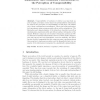Free Online Productivity Tools
i2Speak
i2Symbol
i2OCR
iTex2Img
iWeb2Print
iWeb2Shot
i2Type
iPdf2Split
iPdf2Merge
i2Bopomofo
i2Arabic
i2Style
i2Image
i2PDF
iLatex2Rtf
Sci2ools
HAPTICS
2008
IEEE
2008
IEEE
Kinaesthetic and Cutaneous Contributions to the Perception of Compressibility
Abstract. Compressibility or hardness of objects is an important aspect in haptic perception. Both cutaneous and kinaesthetic information are used for the perception of compressibility. In this paper, the relative role of these contributions is investigated. This is done with psychophysical experiments using a purpose-made silicon rubber stimulus set. The fabrication and characterisation of the stimuli are described, as well as discrimination experiments with and without surface deformation of the stimuli. With the cutaneous cues of surface deformation present, the Weber fraction for hardness discrimination was 0.12. When surface deformation was removed and only kinaesthetic cues were available, the Weber fraction doubled, suggesting that the cutaneous sense contributes almost three quarters to hardness perception, and the kinaesthetic just over one quarter, if the information is integrated in a statistically optimal fashion. Key words: Hardness, Softness, Compliance, Weber fraction
| Added | 29 May 2010 |
| Updated | 29 May 2010 |
| Type | Conference |
| Year | 2008 |
| Where | HAPTICS |
| Authors | Wouter M. Bergmann Tiest, Astrid M. L. Kappers |
Comments (0)

